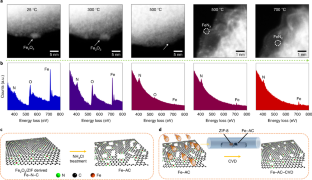長さ2.6nmの単一分子ワイヤーは準金属的な性質を持ち、ワイヤーを長くするとコンダクタンスが異常に増大することが判明、その優れた伝導性は分子エレクトロニクス分野で大きな期待が寄せられている。 A 2.6nm-long single molecule wire has quasi-metallic properties and shows an unusual increase of conductance as the wire length increases; its excellent conductivity holds great promise for the field of molecular electronics
2022-07-06 コロンビア大学
研究グループは、化学設計と実験を組み合わせることで、一次元のトポロジカル絶縁体(TI)を作り出し、ある量が現在の値に比例して減少する過程を表す公式である「指数関数的減衰の法則」を破ることに成功した。さらに、2つのラジカル端の状態を利用して、分子内に高導電性の経路を生成し、「逆導電性減衰」、すなわち、電線の長さが長くなるほど導電性が高くなる系を実現した。
研究者達は、ビス(トリアリールアミン)分子シリーズを設計・合成し、化学酸化によって、一次元TIの特性を示しました。そして、ソース電極とドレイン電極の両方に分子を接続した単一分子接合のコンダクタンス測定を行った。その結果、分子が長いほど高いコンダクタンスを示すことがわかり、ワイヤがヒトのDNAの鎖の直径である2.5ナノメートルより長くなるまで機能することが確認された。
<関連情報>
- https://www.engineering.columbia.edu/news/led-columbia-engineering-researchers-build-longest-highly-conductive-molecular-nanowire
- https://www.nature.com/articles/s41557-022-00978-1
モノラジカルおよびジラジカルカチオンを用いた高伝導性単一分子トポロジカル絶縁体。 Highly conducting single-molecule topological insulators based on mono- and di-radical cations
Liang Li,Jonathan Z. Low,Jan Wilhelm,Guanming Liao,Suman Gunasekaran,Claudia R. Prindle,Rachel L. Starr,Dorothea Golze,Colin Nuckolls,Michael L. Steigerwald,Ferdinand Evers,Luis M. Campos,Xiaodong Yin & Latha Venkataraman
Nature Chemistry Published:07 July 2022
DOI:https://doi.org/10.1038/s41557-022-00978-1

Abstract
Single-molecule topological insulators are promising candidates as conducting wires over nanometre length scales. A key advantage is their ability to exhibit quasi-metallic transport, in contrast to conjugated molecular wires which typically exhibit a low conductance that decays as the wire length increases. Here, we study a family of oligophenylene-bridged bis(triarylamines) with tunable and stable mono- or di-radicaloid character. These wires can undergo one- and two-electron chemical oxidations to the corresponding mono-cation and di-cation, respectively. We show that the oxidized wires exhibit reversed conductance decay with increasing length, consistent with the expectation for Su–Schrieffer–Heeger-type one-dimensional topological insulators. The 2.6-nm-long di-cation reported here displays a conductance greater than 0.1G0, where G0 is the conductance quantum, a factor of 5,400 greater than the neutral form. The observed conductance–length relationship is similar between the mono-cation and di-cation series. Density functional theory calculations elucidate how the frontier orbitals and delocalization of radicals facilitate the observed non-classical quasi-metallic behaviour.



